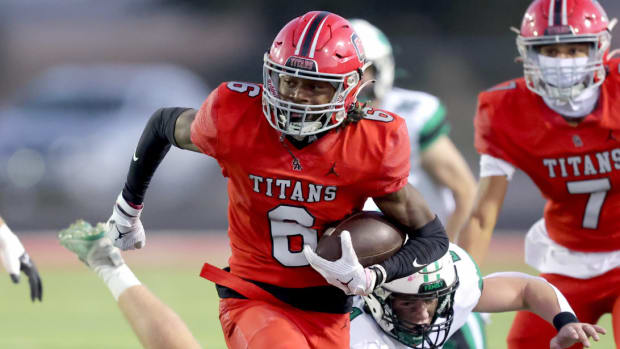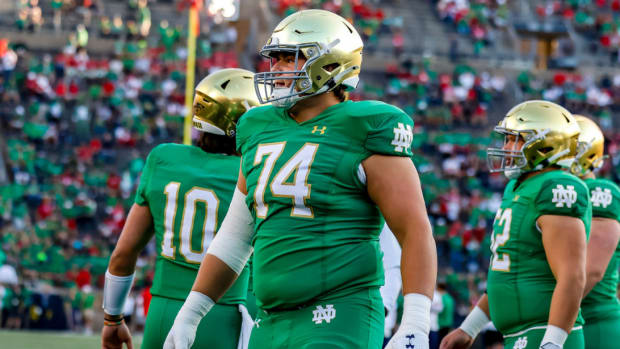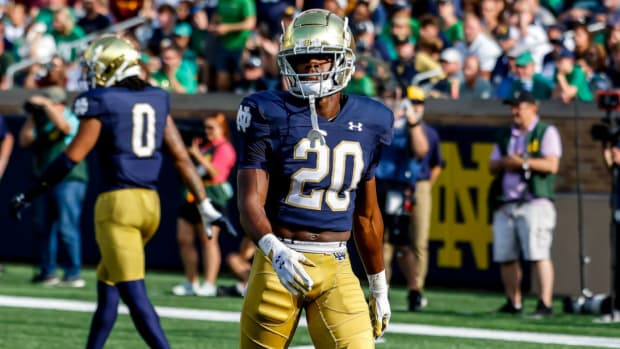Notre Dame Run Defense Still Needs Improvement
When Mike Elko and Clark Lea arrived at Notre Dame prior to the 2017 season they inherited a defense that was in shambles. The Irish were coming off a three-year stretch in which the Irish defense gave up 27.0 points per game, and it was the worst stretch of run defense in school history.
Notre Dame failed to finish in the Top 50 in defensive efficiency (Fremeau Efficiency Index) in each of the three seasons prior to their arrival.
The new staff got the defense on track immediately, showing significant improvement in year one. Elko left for Texas A&M after just one season and Lea was promoted to the lead man on defense. Over the next two seasons the Irish defense has become one of the 10-15 best in the country.
In the last three seasons, Notre Dame has given up just 19.2 points per game and has ranked 11th, 16th and 5th in efficiency.
Notre Dame is playing defense at a level that gives the Irish a chance to be a consistent playoff contender. But there is still another level the defense can get to in order to be good enough to not only compete for a playoff spot, but to be the foundation of a team that can win a national championship.
The one area where the defense needs to continue making its most improvement is defending the run. Before I explain, take a look at this graph:
YPA - Yards per rush attempt
3rd D - Third-down stop rate
PYPA - Yards allowed per pass attempt
PD EFF - Pass efficiency defense
One quick note before diving into this data and what it means, I removed the Navy games from Notre Dame’s numbers, and did the same for Ohio State’s 2014 defense. The reason is you could hold a triple option opponent to 100 yards or more below its season average (which is a great performance) and still give up over 200 rushing yards. Playing Navy skews numbers, simple as that.
Now, onto the discussion about the Irish run defense.
LSU had an interesting run defense in 2019. The numbers are comparable to the 2018 Irish defense, and it’s yards per attempt are almost exactly what Notre Dame was in 2019. But LSU had one really bad game that skewed its numbers, and that must be considered. LSU gave up 402 yards against Ole Miss, but in its other 14 games the Tigers gave up just 100.7 yards per game and 3.2 yards per attempt.
That is an example of why numbers need context and can’t just be provided without discussion.
The point of all this is that teams that win championships have many important ingredients, and one is they usually play really, really good defense. The three champs that gave up more than 110 rushing yards per game averaged 44.8, 39.2 and 48.4 points per game on offense, so they something that could overcome any occasional issues with their run defense.
Alabama has dropped in recent seasons, giving up 121.3 yards per game in 2018 (a year in which they got blown out by Clemson in the title game) and their 2019 run defense gave up 137.2 yards per game and 3.82 yards per rush.
Alabama missed the playoff for the first time despite scoring 47.2 points per game because it gave up an average of 43 points, 173.5 rushing yards and 4.7 yards per attempt in its two losses. Alabama has gone away from what made it an elite football team, and despite having the two best offenses in program history the Tide have been blown out in the title game and then missed the payoff.
Defense is still a very, very important part of winning championships.
In the graph above you’ll see that Notre Dame’s pass defense the last two seasons has been outstanding. Their yards allowed per attempt and efficiency numbers are elite, top five to six numbers, and Notre Dame has allowed just 23 touchdowns the last two seasons while picking off 21 passes.
Notre Dame must become a more effective run defense while maintaining its high level of pass defense. Doing so will improve the other number where the defense must improve, and that’s on third-down. A strong run defense means fewer yards on the ground on first and second down, which puts offenses in tougher third-down situations, and when you’re playing a defense as good as Notre Dame’s, third-and-medium and third-and-longs are going to turn into punts or turnovers.
There are three areas where the Irish defense can improve to get to this level:
1. More Run Game Production Inside — We saw a jump in production inside in 2019, as the defensive tackles made five more run game tackles for loss than they did the previous season, but the Irish still need a lot more on-ball production up front. A defensive tackle getting penetration and forcing a back to cut can result in a short loss or gain, with a linebacker or safety making the stop. A defensive tackle actually making the play on the ball usually results in an even bigger loss for the offense.
Over the last two seasons, Notre Dame’s defensive tackle depth chart averaged just one total tackle for loss per game and 0.5 run game tackles for loss (removing sacks).
Compare that to LSU, whose defensive tackles averaged 1.7 tackles for loss per game and 1.3 run game tackles for loss per game.
Compare that to Clemson in 2018, whose defensive tackles averaged 2.3 tackles for loss per game and 1.5 run game tackles for loss per game.
2. Clean Up Linebacker Play — Notre Dame’s linebackers were highly productive in 2019, combining for 30.5 tackles for loss in the run game. That’s more than Clemson’s linebackers had in 2019, and the Tigers played two more games and had All-American Isaiah Simmons. But the Irish linebackers also had more missed tackles and assignment mistakes than we saw the previous season.
If the unit can continue its run game production and clean up the mistakes and missed tackles the group could be a force in 2020.
3. Faster Starts On Offense — This is still a team game, and the fact is the teams that have competed for and won titles have also been much better on offense than Notre Dame. The Irish need to become a more explosive offense, especially early in games.
LSU averaged 27.7 points per game in the first half last season, Clemson averaged 23.3 points in the opening half in 2018 and 33.9 points in the first two quarters in 2016. Ohio State averaged 23.6 points in the first half in 2014.
Alabama, a team that won more with defense in 2017 and 2015, averaged 19.3 and 16.9 points per game in the opening half.
Notre Dame improved to 20.4 points per game in the opening half this past season, but it was at 16.8 in 2018. The issue for Notre Dame, however, has been its first half stats are padded by blowout wins to a much larger degree than we see from the teams that have won titles.
The Fighting Irish offense averaged 15.4 points in the first half against 10 Power 5 opponents. LSU averaged 27.3 first half points against 12 Power 5 opponents and in 2018 the Clemson offense averaged 23.2 first half points against 13 Power 5 opponents.
This is important because when an offense can jump all over an opponent it makes it much, much harder for them to establish balance and get the run game going. The way Notre Dame rushes the passer and plays the pass, forcing opponents to be more one dimensional would make the defense far, far more dangerous and impactful.
Be sure to stay locked into Irish Breakdown all the time!
Join the Irish Breakdown community!
Subscribe to the Irish Breakdown podcast on iTunes.
Follow me on twitter: @CoachD178
Like and follow Irish Breakdown on Facebook





